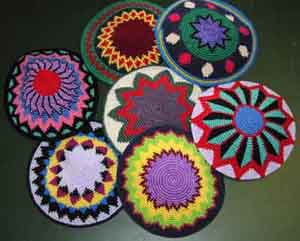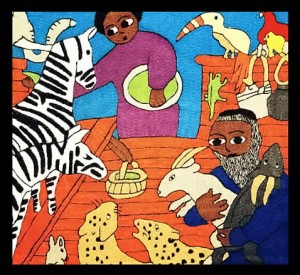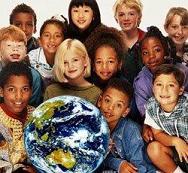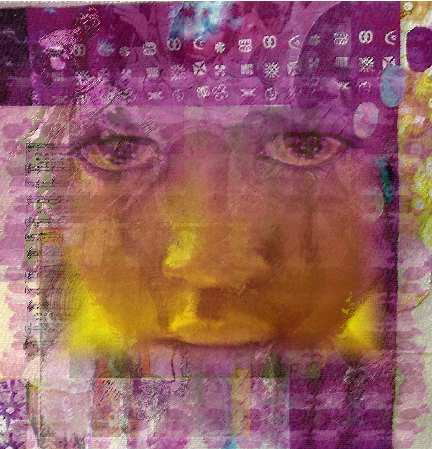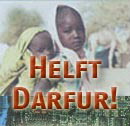Enlightenment
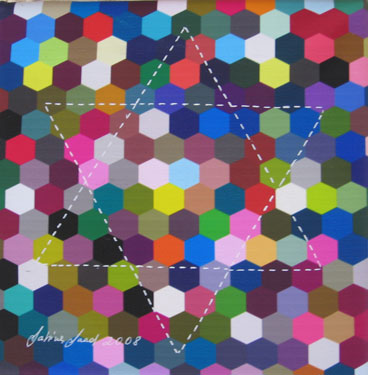 Photograph courtesy of Artist Sabina Saad, The Color of Jews, Yellow Badge Series
Photograph courtesy of Artist Sabina Saad, The Color of Jews, Yellow Badge Series
The Plight of the Non-White Jew
by Jacob Duprey
The Jewish public at large is in jeopardy. They risk becoming as closed minded as those they oppose. The fact is that Jews must expand their definition of what constitutes a Jew. Jews are not a race, they are not genetically distinct nor is their Judaism predicated upon the fact that they were born that way. Additionally not all Jews practice in the same manner and some practices are quite different from the public perception of synagogue. Judaism is in fact a faith, a set of beliefs and a group of people who are united because of what they believe in.
Traditionally a Jew is thought of as a person with dark curly hair, long sideburns, a big nose, a fat wallet and a funny hat. However the definition of a Jew is rapidly expanding. The Israeli and Ashkenazi Jews form only part of the greater whole that is the Jewish Faith. Communities in China have rediscovered their Jewish roots and have begun to practice again. The Black Ethiopian Jews have been around since the 1600’s when they fought for their survival. The Indian Jews, the Bene Israel (Son’s of Israel) claim to have been in existence since the 2nd Century BCE. All of these groups are Jewish, but if seen walking on the streets you would not assume they were Jewish. Thus the original definition of Jew must be expanded to encompass the new definition.
Closer to home, Asian Jews are not taken seriously. I, as a Korean Jew, must every year explain to teachers and friends why I will not be coming in on Rosh Hashanah and Yom Kippur. Everyone I meet must first be introduced to the idea of an Asian Jew. The common response is:
“You’re Jewish?!? To which I must respond “Yes”.
My friend, an Aryan-German Jew, must calmly explain to people that race and religion are independent of each other. Many people seem to believe that Judaism is a race. A common exchange is as follows:
“You’re Jewish?!?”
“Yes”.
“But you’re German!”
“Yea, well they didn’t get all of us”.
A long explanation should not be required to convey one’s religion. This is why a change is in order.
More to the point, not all Jews are born Jewish; although the population of people who convert to Judaism is small. Within my immediate family alone: my Father converted from Catholicism and my brother, sister and I were all converted from the indigent religions of Peru, China and Korea respectively. Although my family does represent something of a racial bouillabaisse it still proves the point that Jews of all shapes and colors do indeed exist and they are asking for public opinions to change.
The school of Judaism that a person follows is another division within our sect. The divisions are as follows: Orthodox, Conservative, Reform, and Reconstructionist. The first two can be thought of as the traditional forms of Jewish study and prayer, the Orthodox representing the more strict and formal of the two and Conservative being the more colloquial of the two. Orthodox services are conducted in the traditional manner, in some cases even separating men from women. Conservative services are run much like a standard church service, except in Hebrew. The last two are rather different from what usually springs to mind; often prayers are said in English or members of the congregation may offer up their own suggestions. Reform Synagogues are not as formal, allowing for provocative thought and changing of customs and prayers. Reconstructionist, to which I belong, encourages challenging the old faith and improving it as an effect of time. All of these schools of thought are Jewish but the latter 2 would be thought of as less “Jewish”. This is simply not true and thus we must change our vision of what it is to be “Jewish”.
Judaism is a faith, a set of beliefs and values. It is not predicated on physical traits, genetic lineage or geographic heritage. Judaism is, in my belief, a set of values that gives us conscience and modesty. It is a way of life that gives you something to believe in; it is nothing but faith. A person is a Jew because they profess Judaism, not because they look “Jewish”. Obviously there will always be the stereotype of what construes a Jew but this author begs for a change in what you, the reader, believes to be a Jew. Public perception can change on the whim of a single person as long as the rest of the world believes them. You can be that one person.
(Note: Ethiopian Jews, Beta Israel (House of Israel), are the descendants of the Tribe of Dan, one of the (so-called) Lost Tribes of Israel) For additional information: The Ethiopian Jews of Israel
One People Many Faces
Opening our eyes and our attitudes to the expanding racial and ethnic variety of Jewish life.
Helen Wanderstock had difficulty picturing an Asian child on the bimah becoming a bat mitzvah—until she and her husband adopted a baby of their own from Vietnam. “It’s made me think differently,” says Wanderstock, “about what being Jewish is.”
For Wanderstock, whose background is Russian and Polish, it’s important for her daughter to know as much as possible about both her Jewish and Asian heritages: Sarah Jae Thuyhien, now 6, was converted at 10 months with three rabbis in attendance. She will soon start Hebrew school, asks for Yiddish lullabies at bedtime and looks forward to celebrating the Vietnamese New Year with a “Tet party” each February. She is named for her Ashkenazic grandparents, but has also retained her Vietnamese name, meaning “gentle/friendly,” because, says Wanderstock, it was the only thing she came with except for one bottle. “There used to be such a stereotypical picture of what the average Jewish kid looked like,” says Wanderstock. “Now, within and outside the Jewish community, there’s more openness and welcoming.”
The face of the American Jewish community is changing. According to the Institute for Jewish and Community Research (IJCR), at least 20 percent of American Jews are racially and ethnically diverse, including those of Sephardic/Mizrahi (Middle Eastern), Asian, Latino, African-American or mixed-race heritage. Many racially and ethnically diverse Jews are born Jewish, and many more enter though the portals of conversion and adoption. In The Colors of Jews (Indiana University), author Melanie Kaye/Kantrowitz estimates that 20,000 to 30,000 marriages between Jews and African-Americans grew out of the civil rights movement.
The IJCR Web site notes that “Jews were considered nonwhite by the American majority well into the 1950s. On the timeline of Jewish existence, the white status of Jews is somewhat of a novelty.” Despite that, says Judith Rosenbaum, director of education at the Jewish Women’s Archive, unspoken assumptions still exist—that almost all American Jews have Eastern European, Ashkenazic roots; that Yiddish is the language of our ancestors; that people of color in the Jewish community must be adopted or Jews by choice. And those assumptions don’t even take into account gender, sexual orientation, disability, occupational, socioeconomic and geographic issues.
The challenge, says Rosenbaum, is to explode the mythic ideal of “normal” in order to expand how we think about our community. “Diversity is not just a marginal issue,” she says, “but one that is central to the way we define ourselves in terms of identity, belonging and structure. Our goal is not just accuracy in portraying the variety and richness of Jewish heritage, but what this accuracy makes possible: fostering a sense of belonging and inclusion.”
Moji Pourmoradi, 39, who was born in Tehran and emigrated with her family to the United States when she was 5 months old, says there is an awareness of “others” in the American Jewish community, but “there isn’t such an openness. For the most part, American Jews like American Jewry. They are a little intrigued by Sephardic Judaism or Judaism that differs from theirs, but they also can be intimidated by the differences—especially cultural ones.”
Pourmoradi married within the Persian Jewish community and lives amid many Persian Jews in Great Neck, N.Y.—a community with at least five Orthodox Persian synagogues. She, however, belongs to the Ashkenazic Conservative Temple Israel, which has a large percentage of Persian Jewish members. Her children, Amy, 10, Rachel, 8, and Dayna, 4, attend public school and the synagogue Hebrew school. (Pourmoradi also just had a baby.) The Pourmoradis speak Farsi at home; the children understand, but answer in English.
Every Friday night, Pourmoradi’s extended family gets together for Shabbat dinner. A small dinner includes 20 to 30 relatives; a large one, 70 to 80. “We do everything in the Persian melody except ‘Shalom Aleichem,'” she says, explaining that as teenagers, she and her sister had participated in United Synagogue Youth events and came home wanting to sing the Ashkenazic melody they had learned. That tradition continues.
“We live in an Ashkenazic world with some Sephardic traditions,” says Pourmoradi. “I combine them because I live in America and there is beauty in both. The fact that there are differences and commonalities is one of the most beautiful things about Judaism.” She calls her vision of American Judaism a “salad bowl,” as opposed to a melting pot. “You’re still a tomato—not a cucumber—but you taste good together. You can integrate traditions but retain your individuality.”
Gary Tobin, president of the IJCR, says that it is dangerous to stir everyone who differs from the stereotypical Jewish image into one pot. He recalls a recent panel on diversity featuring a lesbian Jew, a black Jew and a disabled Jew. “That is a huge mistake and incredibly demeaning,” says Tobin. “It implies that if you’re not like me, you’re odd—and all you oddballs belong together.” Though there may be similarities, “is the issue of a gay couple raising a black child the same as an African-American Jew negotiating synagogue membership?”
“We’ve always been an amalgam of tribes and peoples, and we should reflect that complexity,” Tobin explains. “You can’t wander the globe for 2,500 years and not be like everyone else. Do we know about the Jews of Nigeria, Zimbabwe, Uganda? Not really. Peru? Colombia, Jamaica? About the migration to Israel of Jews from Arab lands? Do we know that the first Jews in the New World were Sephardic Jews?”
Tobin and his wife, Diane, IJCR’s associate director, believe so strongly that the Jewish community’s strength lies in its diversity that they created “Be’chol Lashon: In Every Tongue,” an initiative to create a more racially, ethnically and culturally inclusive Jewish community. Diane Tobin, Be’chol Lashon’s director, works with Jewish community leaders around the world as well as with organizations nationally to do more effective outreach. “Diversity is a bit of a buzzword,” she says. “People are interested in the topic but are struggling with what diversity even means.” Be’chol Lashon has narrowed its focus to ethnic and racial diversity, but even within those categories, the language we have is “admittedly inadequate,” she says. For instance, the Sephardic community doesn’t consider itself “of color,” but still feels marginalized.
In an era of 50 percent intermarriage, “it’s only to our benefit to welcome in other people, to be part of the marketplace of world religions,” says Diane Tobin. “The Jewish community must move beyond our current state of self-imposed stagnation or risk nourishing the roots of our own irrelevance.” For young Jews growing up in America, a society of free choices and equal rights, an all-white, segregated community doesn’t resonate—but being part of a global people does, she adds.
“The concept of k’lal Yisrael—one people—doesn’t mean we all have to be the same,” says Rosenbaum. “There’s a texture and richness to our diversity. It’s a myth that you can go to a synagogue in any part of the world and feel comfortable. We’ve absorbed from and given to surrounding cultures and we shouldn’t be embarrassed about that. Flexibility is important to survival.”
 |
People with the most ambivalence about their own Jewish identities are often the ones who challenge me the most. —Angela Warnick Buchdahl, the first Asian-American Rabbi and Cantor |
As a child, Angela Warnick Buchdahl believed she and her sister were the only ones in the Jewish community with Asian faces. When she was five, she, her sister and parents—an Ashkenazic Reform father and a Korean Buddhist mother—moved from Seoul, South Korea to Tacoma, Washington. One year, she recalls, her mother put kimchee, a spicy, pickled cabbage condiment, on the Seder plate, a “reasonable substitution” since kimchee and horseradish elicit a similar sting.
“I knew my family was atypical, but I was made to feel at home in the synagogue and community,” says Buchdahl. Throughout her youth, however, she fielded comments like, “Funny, you don’t look Jewish.” While living in Israel, feeling “marginalized and invisible,” she called her mother to say she no longer wanted to be a Jew. “My mother said, ‘Is that possible?’ At that moment I realized I could no sooner stop being a Jew than I could stop being Korean, female or me.” In a giyyur ceremony at the mikvah, she reaffirmed her Judaism.
As she continued studying Jewish history and culture, she found it “very powerful to learn that being of mixed race in the Jewish community was not just a modern phenomenon. We were a mixed multitude when we left Egypt and entered Israel, and the Hebrews continued to acquire different cultures and races throughout our diaspora history.”
Buchdahl was invested as a cantor at Hebrew Union College-Jewish Institute of Religion in 1999 and ordained as a rabbi in 2001—the first Asian-American in North America in either position. She currently serves as cantor of Central Synagogue in Manhattan. “When I am in a community for a time, people stop thinking, ‘She’s the Asian rabbi’ and just think of me as the rabbi, or the cantor. When I was younger, people questioned me more. Now they think of it as a point of pride. People have more diverse friends and that is just normal and good.” When a person’s Jewish identity stems from culture—like humor or food—instead of religion, says Buchdahl, a differing cultural identity can be disconcerting. “People with the most ambivalence about their own Jewish identities are often the ones who challenge me the most.”
Things have changed since she was a child, says Buchdahl. On an official level, the Reform movement has embraced intermarried families and children of interracial couples. And through her work on the board of the Jewish Multiracial Network, she has met hundreds of Jews with diverse backgrounds. The Network’s retreats, which attract about 200 people, raise awareness and connect people to each other.
Rabbi Dianne Cohler-Esses, the first non-Orthodox rabbi from the Syrian Jewish community, says that when she has the opportunity, she explains the idea of “Jewish cultures [plural] instead of Jewish culture.” Cohler-Esses absorbed Ashkenazic traditions at Yeshiva of Flatbush and summer camps. Because girls didn’t go to synagogue in the Syrian community, sadly, she didn’t learn a lot of distinctive Syrian customs to transmit. She does have an “acute awareness that the Ashkenazic world isn’t the whole world.” In her journey through the Ashkenazic and Jewish feminist worlds, she says, she often felt her own history “eclipsed.” At the Conservative Jewish Theological Seminary, where she was ordained in 1995, “non-Western Jewish history and culture were largely invisible.”
Her feminist perspective hinders her religious connections to the Sephardic community, since most Sephardic synagogues are non-egalitarian Orthodox. “Where is the world I can be a part of?” asks Cohler-Esses, who serves as Scholar-in-Residence at UJA-Federation of New York. “Food alone doesn’t transmit enough.” The diversity issue remains “huge” for her, but it is another type of diversity: One of her three children has developmental disabilities.
 |
When I would walk into a synagogue, people would stare and gawk. Now they are more discreet in their curiosity and more aware that Jews come in all hues. —Alysa Stanton, UAHC-JIR Rabbinical Candidate |
Like Buchdahl and Cohler-Esses, Alysa Stanton, 44, is also not your stereotypical rabbinical candidate. Raised Pentecostal Christian until the age of 12, she will be the first African-American woman rabbi when she is ordained in 2009 by HUC-JIR in Cincinnati. A psychotherapist specializing in grief and loss, and mother of a 12-year-old adopted daughter, Stanton has always broken barriers. Though she says she felt she was “born Jewish—just not to a Jewish womb,” she still had to make it “legal” when she began the conversion process more than 20 years ago. “The Jewish community was not very welcoming to an African-American convert at that time,” says Stanton, whose Hebrew name is Eliana Alyza (meaning “God has answered me and brought me joy”). “When I would walk into a synagogue, people would stare and gawk. Now, they are more discreet in their curiosity and more aware that Jews come in all hues.”
This past summer, Stanton married an Ashkenazic Conservative Jew of Russian heritage. The multicultural ceremony in a Reform synagogue featured traditional Jewish customs as well as an African-American “Jumping the Broom” ritual. Stanton explains that African slaves were not allowed to marry in America, so they literally jumped over a broom to signify a commitment of marriage. The ritual also remembers those still in bondage today. At the reception, Stanton recalls proudly, “Christians and Jews were dancing the hora together.”
Rabbi Capers Funnye of Beth Shalom B’nai Zaken Ethiopian Hebrew Congregation, a synagogue of African-American Jews established in Chicago in 1915, says smaller, liberal Jewish communities tend to be more welcoming of black Jews. “It is not as surprising or stunning to them to see a black Jew as it is in other Jewish environments where being both African-American and Jewish seems almost an impossibility.” He recalls a visit he made to one synagogue; though he had brought his own tallit, siddur and kippah, after the service someone asked if he was Jewish. “I don’t get angry anymore,” he says. “I realize everyone is at a different place.”
Most of Beth Shalom’s 180 members are Jews by choice. “What could be better than being like Abraham, who also made the choice to cross over?” says Funnye. Some members are Ashkenazic Jews, especially those who have adopted African-American children and want them to be in a place where they are the majority. The synagogue is one of eight affiliated with the International Israelite Board of Rabbis; of the others, four are in New York, and one each are in Philadelphia, Atlanta and Barbados. The community believes the ancient Israelites were of African descent. Many prefer the terms “Hebrew” or “Israelite,” with their Biblical overtones that avoid the association of Jewishness with whiteness. The synagogue is closest to modern Orthodox with Conservative and African-American influences; most of its distinctive melodies are composed by members.
After a local television station did a segment on Beth Shalom, the synagogue put the video on YouTube to get its message out. In four months, it received 30,000 hits from Jews of all denominations all over the world. “The ears of people are becoming more sensitive to hearing the Shema with a different melody and realizing that even if the melody is a little different, our commitment to the Shema and Torah and other Jews is just as strong,” says Funnye. “I want to change the perception of Judaism as a closed club into one that is welcoming of the seeker.”
Helen Wanderstock also wonders how welcoming the traditional Jewish community will be to her daughter. She worries about whether Sarah Jae will fit in at Hebrew school, and even projects forward a few years. “Is some nice Jewish boy going to take my daughter home and his parents will object because she is Asian? I look for reassurance in the wedding section of The New York Times for pictures of Asian girls and Jewish boys. I don’t want my daughter to have tzuris because she is Jewish and ‘doesn’t look Jewish.'”
Because Sarah Jae is Asian, Wanderstock feels she has to be more dedicated in providing a strong Jewish background. Her own assimilated childhood fuels that motivation. Wanderstock’s family celebrated both Hanukkah and Christmas. She didn’t have a bat mitzvah, and on her 13th birthday, she confided in her journal: “Maybe I let the Jewish people down.” She dated Catholic boys until she married her Jewish husband. “My Judaism was my ethnicity, but it didn’t feel like my religion,” she says. Wanderstock later celebrated her adult bat mitzvah at the age of 32.
Throughout her life, Buchdahl, too, felt the competing influences of her Jewish, Korean and American identities. “I often feel as if this one takes precedence and that one gets subsumed,” she says. “It took me a long time to understand that they inform each other and are all part of who I am.” Her husband, Jacob, doesn’t “look stereotypically Jewish,” either, she says: He is blond and blue-eyed. Now that her Jewish identity is front and center, Buchdahl struggles with how much of their Korean heritage she is imparting to her children, Gabriel, 7, Eli, 5, and Rose, 2. Gabriel and Eli will begin attending a Jewish day school next year. They absorb Korean values and culture from their extended Korean family.
Buchdahl’s vision of the future? “I would like to see the Jewish community not only run token programs, but incorporate the stories and traditions of the larger Jewish community. I’d like to see these stories and traditions recognized as being a perennial part of our history instead of somehow diluting ‘pure Jewish culture.'” The most important thing she can do, she says, is to “just be who I am, showing people that I have a Jewish soul and I create Jewish memories with them that will perpetuate true Jewish culture.”
One: Don’t miss the boat.
Two: Remember that we are all in the same boat.
Three: Plan ahead. It wasn’t raining when Noah built the Ark.
Four: Stay fit. When you’re 600 years old, someone may ask you to do something really big.
Five: Don’t listen to critics; just get on with the job that needs to be done.
Six: Build your future on high ground.
Seven: For safety’s sake, travel in pairs.
Eight: Speed isn’t always an advantage. The snails were on board with the cheetahs.
Nine: When you’re stressed, float a while.
Ten: Remember, the Ark was built by amateurs; the Titanic by professionals.
Eleven: No matter the storm, when you are with God, there’s always a rainbow waiting.
Thirty years – officially – after the first Ethiopian Jews set foot on Israeli soil, the first Israeli film about the Ethiopian community of the Holy Land is being released in theaters on Thursday.
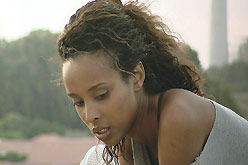
Filmmaker Shmuel Beru, who made aliya from Ethiopia at the age of eight, hopes to show Israeli audiences the richness of his community with Zrubavel, his first full-length feature film.
Even after three decades, all that most Israelis know about this population of more than 110,000 is what they read in newspaper reports: problems of integration, juvenile delinquency, domestic violence – or, more rarely, one successful Ethiopian immigrant who becomes a doctor, a pilot or a famous singer or actor. But what do we really know about the Ethiopian Jews of Israel – their values, their traditions, their language, their music, their food, their dreams, their problems and how they deal with them, their feelings?
These are the questions that Beru, 33, who started as an actor, wanted to answer by getting behind the camera.
In Tel-Aviv’s Kerem Hateimanim neighborhood, a two-minute walk from Rehov Zrubavel, where he lives, Beru agreed to talk to The Jerusalem Post about this original project.
The idea came to him two years ago, he says. “I thought that in my community, there were a lot of stories to tell that others are not exposed to. So I decided to make a movie to relate them, thinking that if I don’t do it, nobody will do it for me.”
BERU PRESENTS a picture, sometimes happy, sometimes sad, of a group of residents in an entirely Ethiopian neighborhood. All the generations are represented, from the patriarch of the Zrubavel family – a colonel in Ethiopia, now a street sweeper in Israel – to his eight-year-old, Israeli-born grandson Yitzhak – alias “Spike Lee” – whose dream is to make movies.
Through the eyes of the latter, Beru – who arrived from Ethiopia via Sudan one year before Operation Moses in 1984 – tells the story of Yitzhak’s aunt, Almaz, the “most beautiful girl in the neighborhood.” A talented singer, Almaz wants to marry a distant cousin, despite her father’s injunction to respect the traditional rule of not marrying a relative within seven generations. Meanwhile, Almaz’s brother Gili, pushed by his father, tries despite racism to enter a selective school to become an IAF pilot, as Yitzhak’s parents fight over whether their son will enter a yeshiva or become a soccer player.
“My goal was to show that behind color and culture, there are human beings,” says Beru. “I wanted to create an opportunity to see us [Israeli Ethiopians] in a different way than people are used to, to go further than what the news released about us, to make people realize that we are not different from others.
“‘It doesn’t matter where you come from, you are just a person’ – this is the main point of my movie, and it is not only true for Ethiopians. Zrubavel tries to talk about integration in general, and its message can be applied to every other community.”
Although he had never directed before, Beru was undeterred.
“My theory is, if you want to do it, just do it. I need a script? So I wrote a script. I need actors? So I found actors. I need money? Okay, I don’t have money. I need to raise it. I presented my project to a few producers. I got only negative answers. So I invest my own money to direct a pilot. And I win the support of the Israel Film Fund and the Gesher Foundation. And I started.”
DESPITE LIVING in Israel for 25 years, Beru says he still feels “different.”
“I still feel I am not judged just as a person, but regarding my origins, my color,” he explains. “People like to divide other people into groups. I don’t know why, maybe it’s easier for them to say, ‘You, you are from outside, you are a foreigner, you just came to visit.’ And this is what is exposed in the movie. This neighborhood [in the film] is like a ghetto, not connected to the other groups of society, to the rest of the world, and it affects its residents.”
One of the issues Beru addresses in the movie is the gap between the older and younger generations in the community.
“For the youth, it’s hard because they feel half-half – on the one hand, they want to be like Israelis, and on the other, they want to be like Ethiopians. And it is difficult for them to find a good balance, to mix. Especially when they have to face the reaction of their parents, themselves in a struggle to deal with a new culture and lifestyle very different from their old one,” he says.
Beru also shows “a typical Israeli family” trying to contribute to their country.
“The father is very Zionist. [He] wants his son, Gili, to defend his country, even though he already lost another son in the army. He wants him to be a pilot and to be recognized as a part of society,” he says.
Beru admits that the character of Yitzhak, the young filmmaker, could be a reflection of himself, although he hadn’t planned it that way.
“Yitzhak is just a naïve little boy who wants to do a movie, very simple, with his handmade camera,” he explains, adding, “In this business, everyone wants to be Spike Lee and wants to be a voice for their own community.”
Beru’s next film project is a personal account of his own experiences coming to Israel.
“It will talk about my life, about my journey from Ethiopia to Israel via Sudan. I already have a script,” he says. “Now I look for funds to start; it will be huge production.”
![]()
Rest in Peace MJ
August 29, 1958 – June 25, 2009
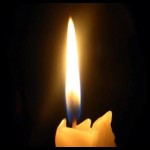
Now, more than ever, with Iraq, Iran, and others, claiming the Holocaust to be ‘a myth,’ it’s imperative to make sure the world never forgets, because there are others who would like to do it again.
How can people be so heartless…Easy to Be Hard
How can people be so heartless
How can people be so cruel
Easy to be hard, easy to be cold
How can people have no feelings
How can they ignore their friends
Easy to be proud, easy to say no
Especially people who care about strangers
Who care about evil and social injustice
Do you only care about bleeding crowd
How about a needing friend, I need a friend
How can people be so heartless
You know I’m hung up on you
Easy to be proud, easy to say no
Especially people who care about strangers
Who care about evil and social injustice
Do you only care about bleeding crowd
How about a needing friend, we all need a friend
How can people be so heartless
How can people be so cruel
Easy to be proud, easy to say no
Easy to be cold, easy to say no
Come, on, easy to give in, easy to say no
Easy to be cold, easy to say no
Much too easy to say no
Reminder…Jews Come in All Colors
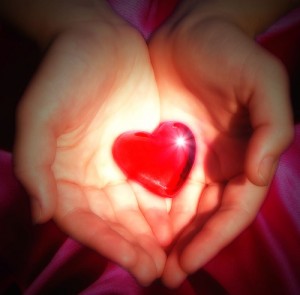
Play Music: Song For My Father:
Song_for_Father_CD_Reverb
Shared via AddThis
SONG FOR MY FATHER
If there was ever a man
Who was generous, gracious and good
That was my dad
The man
A human being so true
He could live like a king
‘Cause he knew
The real pleasure in life
To be devoted to
And always stand by me
So I’d be unafraid and free
If there was ever a man
Who was generous, gracious and good
That was my dad
The man
A human being so true
He could live like a king
‘Cause he knew
The real pleasure in life
To be devoted to
And always stand by me
So I’d be unafraid and free
If there was ever a man
Who was generous, gracious and good
That was my dad
The man, The man
~Horace Silver
Father, Father by NYOIL
Shalom, Salaam, Peace (English Subtitled) by HaDag Nachash
![]()
HaMasa l’Eretz Yisrael (The journey to the Land of Israel) – an Israeli-Ethiopian song Performed by Shlomo Gronicj and Lehkat Sheba
Darfur Solidarity Fast
Monday and Tuesday, June 15 and 16, I’ll be part of an international
“fasting chain,” going without food for two consecutive days in solidarity with
the people of Darfur.
Fast in solidarity with the hungry and starving in Darfur and for lasting peace in Sudan!
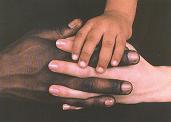
Loving Day is named after Loving v. Virginia, the Supreme Court case that legalized interracial marriage in the USA. It’s a project that connects the multicultural community.
Mr. and Mrs. Loving were a real couple who fought for their right to marry regardless of race.
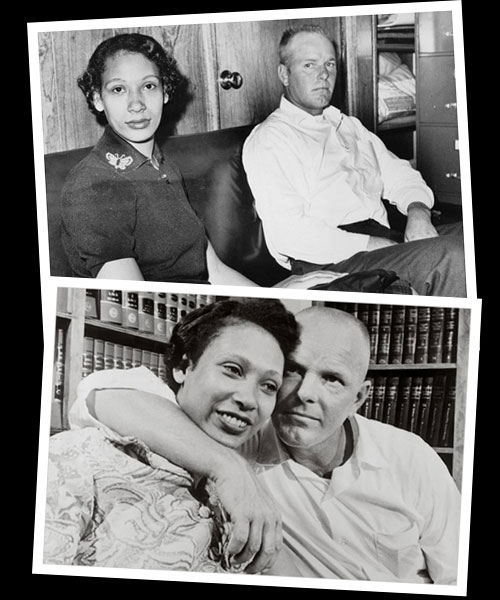
Mr. and Mrs. Loving
Loving Day fights racial prejudice through education and builds multicultural community.
Loving Day Celebrations happen around June 12th. Find a celebration near you








